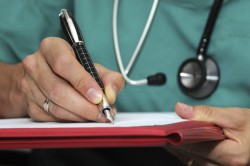Whether you are going into drug treatment, your teen is, or you have a family member in treatment, you will eventually need to talk to your teen about the treatment. Chances are they are unsure of what happens during it. You will need to choose the right time to talk, have starters, and actually be able to explain treatment.
Use Teachable Moments to Pick Your Time for the Talk
Teachable moments are random moments that happen during the day that relate to the subject, in this case drug treatment. Use teachable moments in order to talk to your teen about a family member’s treatment. Some common teachable moments are:
- during a movie featuring rehab
- a celebrity in drug treatment on the news
- someone unrelated who went through drug treatment
You will need to watch for teachable moments when you are considering talking to your teen about drug treatment.
Use a Conversation Starter

Explain how each form of addiction treatment works and why it’s necessary for the addicted family member to attend.
You can use something happening in your teen’s daily life as a conversation starter. This not only lets you learn about your teen’s friends and interests, it opens the door for the teen to talk to you as well, according to the Department of Health and Human Services.
There are other conversation starters that work as well. These are:
- ask what they already know
- talk about someone else in treatment
- ask about another type of treatment such as cancer or physical rehab
- use things in your environment to prompt the conversation
When you talk to your teen, remember they might not want to go to rehab because they are scared. By explaining and starting slowly you can prevent a lot of distress.
Explain What Drug Addiction Treatment Is
There are several key points that you want to hit when you actually get to talking about drug treatment with your teen. Understand that treatment might be a mystery to your teen or they might believe what Hollywood says about it, so there are a few things you want to make sure you touch on. These are:
- what happens during inpatient treatment
- what happens during outpatient treatment
- what an addiction counselor is
- why drug treatment is important
- the schedule
- the rules of inpatient, outpatient, and community treatment
- why each type of treatment is necessary
These are just basic points. Always let your teen ask questions and if you do not know the answer, offer to look it up for them. You might also want to mention that according to the National Institute on Drug Abuse, treatment will vary from person to person and according to what the person is on.
These are all things that you can use to have the conversation that you need to have about drug treatment and how it works, particularly if your teen has to go to rehab. If you want to find a rehab or for more information, call 800-487-1890 (Who Answers?) .
Everyone knows that addiction is a complicated and dangerous disease in and of itself. The ravages of addiction are well documented, and can include suicide, depression, and anxiety. Even though a large portion of the physical damages from addiction are well known. What may not be well known, are the diseases that often come from drug use and addiction. Here are three of the worst diseases that you never thought your addiction would lead to.
HIV
Human immunodeficiency virus has no cure, and is extremely difficult to treat. Not only this, but even with early and aggressive treatment, there is absolutely no doubt that it will eventually cause the death of someone suffering from it. HIV and its subsequent disorder AIDS, damages the body’s ability to fight off illness and disease. The only treatment involves high dosage antiviral medications that only serve to slow down the spread of HIV.
It is spread through contact with infected bodily fluids, and can be obtained from unprotected sexual contact and needle sharing. Both of these situations are common among addicts. In fact, according to the National Institute on Drug Abuse, heroin users are far more likely to contract HIV and hepatitis than other people. If you have a drug problem and HIV we can help, call us at 800-487-1890 (Who Answers?) .
Hepatitis B

Needle sharing can spread hepatitis B, which causes flu-like symptoms.
Viral hepatitis is a disease that causes liver damage, and is transferred from contact with infected bodily fluids. Viral hepatitis comes in a number of varieties, with hepatitis B being one of the most common and most dangerous. Needle sharing is believed to the most common means of spreading the disease, as it is primarily spread through contact with infected blood.
Hepatitis B begins as an acute condition that inflames the liver causing jaundice, abdominal pain, and flu-like symptoms. If it is not treated promptly, it can develop into a chronic condition that has no cure and continues to damage the cells of the liver. This, in turn, may cause liver failure and death.
Heart Disease
Heart disease is the leading cause of death among Americans and has been for a number of years. Heart disease generally develops after damage is done to the heart or blood vessels. Everyone knows that cholesterol can cause this kind of damage and understands how it can develop into heart disease. However, addiction can cause even more damage over a much shorter period of time.
According to the American Heart Association, the relationship between drug use and heart disease is very clear. Drug abuse causes many cardiovascular problems including:
- hardening of the blood vessels,
- heart arrhythmia,
- thickening of the left ventricle of the heart,
- infections of the blood and heart valves,
- high blood pressure, and
- heart attack.
All of these problems contribute to heart disease, putting addicted persons at much higher risk of heart disease, massive heart attack, and stroke.
The best way to keep from contracting these diseases from your addiction is to stop using drugs now. There are treatment options available. Call us today at 800-487-1890 (Who Answers?) and let us help you find the treatment that you need so that you can avoid these deadly diseases.
How do You Know that it is Time to Seek Treatment for Your Substance Abuse?
You know the scene in the movie where the person goes off of drugs all on their own. They are sweaty and dirty and they have been locked in a bathroom or chained to a radiator and someone has told them that they can’t leave until they get clean. They clutch their stomach, they heave, they vomit, and they do it all in a couple of days. Yes, there must be at least one person that has done this, but it isn’t effective detox or effective treatment.
“Cold turkey” is the term used for stopping drug use without help and never going back. In traditional terms, it is a kind of detox (the process where you transition from actually high to completely drug and alcohol free). Even if you go through a professional detox program that still isn’t the end. So quitting cold turkey is nearly impossible as a replacement for a full treatment program. You are suffering through detox and then using power of will to keep yourself clean? Yeah, that doesn’t really happen.
When you get ready to stop using drugs and alcohol, you should look into a detox method that works for you, but you should also be prepared to follow it up with structured, professional treatment. One way to help yourself with that process if to speak to experts, like the ones at SubstanceAbuse.org. One call to 800-487-1890 (Who Answers?) can get you answers to questions and connected to centers. You will be one step closer to finding what works for you.
Withdrawal
The biggest drawback to quitting any drug or alcohol is the withdrawal you will have to go through. As the National Institute on Drug Abuse points out, all drugs have different withdrawal symptoms and durations. One thing they all have in common is that they are uncomfortable.

Enduring withdrawal without professional treatment help can be extremely uncomfortable and even dangerous.
For example, heroin withdrawal sets in approximately 12 hours after your last heroin use. Symptoms include:
- Anxiety
- Muscle pain
- Tearing
- Trouble sleeping
- Runny nose
- Perspiring
- Yawning
- Stomach cramping
- Diarrhea
- Goose bumps
- Nausea
- Vomiting
In contrast, cocaine withdrawal typically includes:
- Agitation/restless behavior
- Depression
- Sleepiness
- General discomfort
- Bigger appetite
- Vivid/unpleasant dreams
- Slowing of activity
The symptoms have a few things in common (agitation, trouble sleeping), but they have a lot of symptoms that are different from one another. When you look into proper treatment, you will have an expert assisting you who is familiar with different withdrawal symptoms and trained to alleviate or stop them entirely.
Detox
It’s important to understand how a professional detox differs from a do-it-yourself method.
A home detox can be researched online and it usually involves trying to speed up your body’s natural filtering mechanisms. So, you drink lots of water to get urine filtering out toxins and you take a lot of hot baths to get your sweat glands active. But, all the lemon water in the world doesn’t combat drug and alcohol withdrawal.
A professional detox program will lead you through the transition from intoxicated to drug and alcohol free. It is also the first stage in your treatment (something you can’t just will yourself through). A professional detox will urge you to seek some form of treatment.
The model of detox that you are probably familiar with is the medical model, where a staff or doctors and nurses use medication to help you get clean before you undergo rehab. There is also a social model, where a supportive group of peers, instead of clinicians and meds, supports you through your detox before proper treatment.
What Are the Stages of Detox?
According to the Substance Abuse and Mental Health Services Administration (SAMHSA) detoxification has three parts: evaluation, stabilizations, and nurturing patient readiness for treatment and their entry into that treatment.
During evaluation, you are:
- Tested for the presence of drugs and/or alcohol in your body, the amount of each will be measured.
- Screened for any other psychological or medical condition
- Evaluated by your medical and psychological conditions, as well as your social situation
During stabilization, you are:
- Transitioned through acute intoxication and withdrawal into a substance-free position
- Fully supported by treatment staff
- Pu through a medical and psychosocial process
During the final step, you are:
- told about the importance of following through with drug and alcohol treatment
- Prepared to enter that treatment
You can’t replicate these circumstances in your bedroom and you certainly can’t be responsible for fully supporting yourself through a cold turkey approach. You shouldn’t have to. Let people help you. Call Our helpline at 800-487-1890 (Who Answers?) .
Many people that develop a substance abuse disorder begin using these substances when they are young. There are countless websites devoted to using and obtaining illicit substances.According to the National Institute on Drug Abuse, there are many clear signs that a teen is using drugs or alcohol. Unfortunately, teens often find ways to hide these signs. Here are some ways that your teen may be hiding drug or alcohol use.
Spending Large Amounts of Time Locked in their Room
Everyone knows that teens can be moody and stand-offish at times. However, when this becomes a regular occurrence it is likely that they are hiding something, such as drug or alcohol use. This is especially true if it is out of character for them to behave this way, or if they suddenly start locking every door behind themselves.
Being Away from the House when you Do Not Know Where they Are

If your teen starts locking themselves in their room on a regular basis, they may be hiding substance use.
Raising teenagers can be delicate balancing act between keeping them safe and allowing them to become an independent adult. Most parents will agree, however, that it is still a good idea to know where your teen is, and who they are with.
Asking Friends to Cover For Them
Every parent can tell you that when their child resorts to dishonesty, especially if they drag someone else into it, they are up to no good. If your teen claims to be staying with a friend, but calls to the friend’s parents tell a different story, something is seriously wrong.
Finding Ingenious Hiding Places for Drugs and Alcohol
Teens can also be very inventive in finding places to hide drugs or alcohol. Some of the more ingenious places include:
- battery compartments
- belt buckles with compartments in them
- behind pictures or posters
- inside gaming consoles
- inside stuffed animals
- in seldom worn clothing or shoes
- in lockets or other compartmented jewelry
- inside bags of candies or candy wrappers
- inside highlighters and pens
- insidelip balm or lipstick tubes
All of these things seem unlikely hiding places for drugs or alcohol, yet can serve that purpose effectively. If you happen to find drugs in any of these things, it is important that you seek help immediately. Usually hiding drugs means a serious drug habit and treatment is necessary. You can find the treatment that your teen needs by calling 800-487-1890 (Who Answers?) .
Turning the Blame on Others for Absences
At one time or another, nearly all teens will fail to take responsibility for their actions. This a normal part of growing up. But, when this is combined with frequently breaking curfews, or being somewhere other than where they should be, it is cause for concern. This may be a sign that they are trying to hide drug or alcohol use.
Using Products such as Visine to Hide Signs of Drug Use
Unless your teen has allergies or other health problems that require the frequent use of eye drops, decongestants, or allergy medications, they may be using them to hide signs of drug use such as red eyes, runny nose, and cough.
If you should discover that your teen is using drugs or alcohol, your first step should be to talk to them about it, rationally and calmly. If you further discover that they have a problem it is up to you to get them the help that they need before they ruin their lives. Call us today at 800-487-1890 (Who Answers?) , and let us help you find a treatment option that is right for you and your teen.
Addiction is a disease not a choice or a moral failing. The addict does not want to be an addict and might be ashamed or embarrassed by their need. This does not mean excuse their behavior. Fortunately, there are ways to protect yourself against the addict living in your house.
Understand that Addicts Lie
According to the National Institute on Drug Abuse, one of the characteristics of addiction is that all addicts lie. Understand that it is a defense mechanism and try not to be hurt by it. There are no easy answers to an addict lying, just make sure you do not fall into believing the lie.
Protect yourself Financially
Unfortunately, addicts also steal. Drug addiction is expensive. This means that your finances are not safe. Do not keep large amounts of cash that are easily stolen and do not allow them access to your financial accounts. An addict can wipe out a major bank account or investment account in weeks if not days. It is best to keep your financial information separate from theirs.
Do Not Enable the Addiction

Rationalizing the addict’s behavior is a form of enabling.
Enabling an addiction comes in many ways. You can enable and addiction by:
- purchasing drugs
- lying for the addict
- covering up the addiction
- rationalizing the behavior
- making excuses for the addict
- bailing them out financially and physically
- cleaning up their social, financial, and other messes
Enabling an addict is one way to encourage them to use drugs and not seek treatment for their addiction. To help find the addict in your household a treatment program call 800-487-1890 (Who Answers?) . We can help you find the treatment that is right for them.
Do Not Allow the Addict to Blame you for their Addiction
A common phrase for addicts to say is that they are addicted because of something you do, don’t do, or say. This is not true, you cannot let an addict blame you for their problems. It is difficult to do but you have to remember that the only person the addict has to blame is themselves.
Make sure you are Healthy
Without good self care, you cannot help the addict. You have to stay healthy in order to deal with the addiction. If you need to leave to do so then leave. Many people wind up letting their own health slide when they are caring for an addicted person.
Change your Behaviors, Do Not use Unhealthy Coping Mechanisms
Make sure in dealing with the addict you are not developing unhealthy coping mechanisms yourself. Do not start using just because someone in your life is using drugs. Although it is easy to develop poor coping mechanisms, it is also easy to develop healthy ones.
Living with a Loved One Suffering from a Substance Abuse Disorder
Join a Support Group
Joining a support group will help you deal with the addict in your life. There are many groups available to help you and support you through this difficult period.
If the Addict is Physically, Emotionally, or Sexually Abusive Get Out
If the addict becomes abusive when they are drinking, you need to get out of the house. There are shelters and organizations that will help you escape the abusive environment. Once you are out, you can then deal with the addiction and aftermath at a safe distance. Never risk your life for an addict.
Help the Addict Find Treatment
If the addict in your household wants treatment, help them find it. You can do this by calling 800-487-1890 (Who Answers?) . We can help you find the treatment that best suits the situation.
The National Institute on Drug Abuse reports there is an increase in illicit drug use in the US. They estimate 24.6 million Americans aged 12 or older—9.4 percent of the population—used an illicit drug in the past month.
You may be one of these people. As you know, seeking rehabilitation for drug and alcohol use is a difficult process and it is one that is impossible to complete in isolation.
Throughout the rehab process, you will look to various people for support that will boost your morale and strengthen your resolve to recover from addiction. And, your need for support won’t end when rehab does.
During the process, you will cultivate relationships that you will rely upon as your recovery unfolds outside of treatment. But, you may not be certain about where to look for support. Don’t worry. The people you can come to rely upon are pretty easy to find, once you start looking.
If you are looking for some immediate support, SubstanceAbuse.org can help. Give us a call to have your questions answered and to be connected with resources and rehabilitation centers. Our number is 800-487-1890 (Who Answers?) , and you can call 24 hours a day.
Family

Your family can show support by joining you in family therapy sessions.
Firstly, it should be acknowledged that many people who develop drug and alcohol dependency or addiction don’t have traditional families upon which to rely. In fact, it is often familial dysfunction the leads people to drugs and alcohol.
In many other situations, substance use disorders are passed from parent to child. In these instances, and ones like them, you don’t need to force a connection where it may ultimately be unhealthy for you and your recovery.
Although, keep in mind that treatment often includes family therapy and you can end up making progress with a family that seemed beyond saving. You never know.
Also, don’t define family as simply the people with which you share DNA. Embrace the concept of an “intentional family”: a group of people you have chosen to bond with like family. This family may include a co-worker, a best friend, a classmate, and people you have known since childhood. When you think of family this way, you discover that you have a greater familial support system than you first recognized.
When you look to your family for support, let them know what you need. They won’t be able to guess or anticipate your needs, especially as you change during recovery. You need to work on rebuilding trust and that starts with communications. Be vocal about your needs and you will get the help you need. There are people in your life who want to support your recovery.
Support Groups
Clearly, support groups can offer support; it’s pretty clearly stated in the title. But, how do you connect with them and take advantage of that support?
Start at your treatment program. It’s possible that former patients meet up or that they have connection with local groups they can refer you to. You may end up in groups with peers that you already feel bonded to.
Next, expand your search. Call churches, hospitals, and community centers. Ask people you went to rehab with. Check online.
When you have a list of possibilities, sample them all. The National Institute on Drug Abuse points out that no particular treatment is correct for everyone. That is true of groups as well.
Online Support Groups
Sometimes, meeting new people can cause anxiety and when you are in recovery anxiety can be an even bigger stressor. This may impact how helpful in-person support groups can be. Although, you should challenge yourself to seek out peers in real life, beginning with an online support group may be easier.
If you still feel anxiety, it’s OK to lurk for a b it and simply read what others have to say. Over time, you will feel connected to the stories of certain users and impacted by the advice given. This will allow you to more fully engage in the community.
The support that you need will be as unique as you and your addiction journey have been. You will know what is right for you. But, it is important that you have a support system, so don’t isolate yourself. For help making it through treatment and transitioning into recovery, call 800-487-1890 (Who Answers?) we can help with your treatment-related needs.
Amphetamine use is detrimental in many ways. Yes, it affects your life and your choices. But, it also affects your friends, your family, your job, your schooling, and your emotional stability. You are probably beginning to realize what amphetamine abuse has done to your life and you are making positive choices to break your pattern of addiction and start healing.
However, addiction itself will make seeking help difficult. In fact, the National Institute on Drug Abuse (NIDA), defines drug addiction as “a chronic, often relapsing brain disease that causes compulsive drug seeking and use, despite harmful consequences.”
You may begin taking drugs voluntarily, but as your brain changes to accommodate addiction, your self-control will be damaged and the urge to use will no longer be something you can resist. Your will to quit will likely not be enough.
When you make the choice to get help, your first step will be an intake. Even if you are simply seeking detox, you will go through an intake because it is important for the professionals helping you to have a thorough understanding of multiple aspects of your life. But, what exactly will that look like? What follows are details of the intake process.
For more information about treatment and recovery, including intake, contact SubstanceAbuse.org at 800-487-1890 (Who Answers?) . We can connect you with resources, set you up with treatment and answer your questions. Give us a call.
The Effects of Amphetamines

It’s important to answer questions honestly in order to develop an effective treatment plan.
Amphetamines gained popularity as mother’s little helpers. They worked miracles for patients looking to treat depression, increase weight loss, decrease fatigue, clear nasal decongestion, and treat narcolepsy and ADHD. They seem like a wonder drug. But, they pose real dangers for people who use them non-medically/recreationally.
The more individuals use them recreationally, the more they face negative physical side effects like:
- Heart problems
- Irregular heart beat
- Headaches
- Troubled vision
- Chest pain
- Skin ailments
Negative psychological side effects include:
- Reduced societal inhibitions
- Changed sexual behavior
- Delusions of personal ability and power
When you enter recovery, you will be choosing to leave these side effects behind. But, before you reach that stage you undergo intake.
Honesty
During the intake process, you will meet with a medical professional to answer a succession of questions and take tests. Clinicians will test for the presence of amphetamines and determine the amount currently in your system. They will also screen for comorbid mental and physical conditions. Prepare for a complete assessment of your medical, psychological, and social circumstances.
You must answer all questions honestly. When you lie, you affect the development of the treatment plan and alterations of the plan will mean that it cannot succeed as easily. Do yourself a favor and help the clinicians gather all the information that they need to do right by you. The National Institute on Drug Abuse notes: “No single treatment is appropriate for everyone.” You need a plan tailored to you and your addiction.
If you feel embarrassed, don’t. Nothing you can tell them will shock them or make them judge you. They are professionals.
The National Institute on Drug Abuse notes: “No single treatment is appropriate for everyone.”
What is a Dual Diagnosis and How Does it Relate to Substance Abuse?
Comorbid Conditions
A treatment plan must address comorbid mental and physical disorders. These are conditions that occur simultaneously for you. For example, you may have both an amphetamine addiction and a heart condition or generalized anxiety. Your treatment plan will need to consider how these conditions impact each other.
As the NIDA states: “To be effective, treatment must address the individual’s drug abuse and any associated medical, psychological, social, vocational, and legal problems.
It is also important that treatment be appropriate to the individual’s age, gender, ethnicity, and culture.” The more honestly you answer intake questions, the better the information gathered will be and the better it will address these various concerns.
If you are ready to begin drawing up a treatment plan and undergoing treatment, contact SubstanceAbuse.org at800-487-1890 (Who Answers?) . They will direct you to treatment centers and resources. Call today.
If you watch the news or listen to the radio you might have heard of DAWN. According to the Substance Abuse and Mental Health Services Administration, DAWN stands for Drug Abuse Warning Network. It is a reporting system so that mental health officials can keep track of drug abuse trends throughout the country. Although technically DAWN itself has been discontinued, the information is still being collected and compiled so that doctors and mental health professionals can see trends in drug abuse.
Who Reports to DAWN?
Most emergency departments report to the DAWN system. Any short term facility that deals with drug addiction, abuse, and the consequences of taking drugs, send their statistics to the Substance Abuse and Mental Health Services Administration. Many short term treatment centers report to DAWN.
This is no to say that your personal information is included in this reporting and it should not stop you from seeking treatment. If you need help for a drug addiction immediately, call 800-487-1890 (Who Answers?) . We can help you find the treatment center you need without compromising your privacy.
Ways to View the DAWN Data

Any facility that deals with drug addiction reports their statistics to DAWN.
There are a variety of ways you can access and read the DAWN data. It can give you a good picture of what is going on with drug addiction, abuse, and treatment. A few of these ways are:
- Emergency Department Reports – these are the reports coming directly from emergency rooms across the country
- National Data – this is a compilation of the statistics across the nation
- Short Reports – short reports are quick facts about mental health and substance abuse trends and statistics
- Methodology – methodology is a report on how the data was collected as well as any inaccuracies that might be present
Many of these reports are then cut down to trends for specific drugs. This way researchers and other interested parties can tell where more preventative measures and treatment facilities are needed.
Where is the Data Collected From
The data comes from a variety of sources. A few of these sources are:
- Substance Abuse Treatment Facilities
- Outpatient Client Data
- Self Reported Data
- Data from Specific Populations
- Emergency Department Data
- Mental Health Facilities
What they submit to the Substance Abuse and Mental Health Services Administration are simply numbers. In no way does this data collection violate your privacy, use names, or addresses in order to get these statistics.
DAWN’s History and Future
DAWN was established by the DEA in the early 1970s. It was designed to help law enforcement and medical personnel identify the drugs that were currently popular to develop treatments for them. Since drug culture is ever changing this information is particularly important to emergency personnel. It helps them to know what they are dealing with.
At the end of 2016 DAWN will be taken over by the National Hospital Care Survey. It will report the same data on a broader scale. They are taking over to streamline the process of reporting. It will also help to identify which areas are in crisis and which are not.
If you are in crisis and need help with your drug addiction, the DAWN system can also help to identify specialized care in your area. If you need help overcoming addiction, call 800-487-1890 (Who Answers?) . We can help identify the best treatment options in your area.
If you suspect someone of using drugs, it is an excellent idea to know what to look for when they are high. Sadly, many parents, grandparents, employers, and siblings do not know the signs of commonly abused drugs. According to the National Institute on Drug Abuse, it is possible to tell which drug someone is on by the symptoms that they exhibit. A few of these signs are very noticeable when someone is on one of the more common drugs.
Marijuana
Due to its current legislative issues, marijuana is becoming more and more popular with a variety of people. Any age group can be addicted to marijuana despite claims that it is not physically addictive. If someone you know is on marijuana you might notice:
- giggling for no reason
- fascination with strange things
- appetite for strange foods
- glassy eyes
- lack of motivation
- lack of interest in things such as going out or doing what they need to
Marijuana users generally keep eye drops and air freshener around to reduce the signs of the drug.
Benzodiazepines

Sleepiness is common among those who abuse benzodiazepines.
Benzodiazepines are a central nervous system depressant that many people take legitimately for anxiety and insomnia. Unfortunately, it is highly addictive and easy to abuse. People without a prescription often take it to get high. Some of the signs a person is using benzodiazepines are:
- sleepiness
- drowsiness
- slurred speech
- acting drunk
- poor decision making skills
- contracted pupils
- lack of concentration
Many people who use benzodiazepines use them legitimately, but others use them to get high. If you or someone you know is addicted to benzodiazepines, call 800-487-1890 (Who Answers?) . It is extremely important that you seek treatment to stop taking them. Benzodiazepine withdrawal can kill you, if you do not withdrawal off the drug in a medical setting.
Inhalants
Inhalants are extremely popular with younger kids who do not have access to other drugs. An inhalant is anything they can inhale to get a rush. Inhalant use is extremely dangerous because of the damage that it does to the brain. Fortunately, there are very obvious signs that someone is using inhalants. These signs are:
- impaired vision
- difficulty concentrating
- inability to retain new information
- inability to think clearly
- red nose and mouth
- rash around the mouth
- poor muscle control
Unfortunately, with inhalants some of these symptoms are permanent.
Heroin and other Opiates
Heroin, opiates, and prescription opiates all have very similar signs of use. These signs are not mistakable for any other drug. Several of these signs are:
- no response to light from the pupils
- pinpoint pupils
- needle marks
- confusion
- twitching
- loss of appetite
- nodding off at inappropriate times
- vomiting
- sweating profusely
If you or a loved one is exhibiting any of the signs of addiction to these common drugs, you should seek treatment immediately. Call 800-487-1890 (Who Answers?) , we can help you onto the road to recovery.
It is surprising with all of the research that scientists do on drug addiction that some common myths still persist. Most of these myths are easily dispelled with a bit of time and research. According to the National Institute on Drug Abuse, there are many myths that need to be explored before you fully understand drug addiction and abuse.
Myth #1: Once you go through Detox you are Not Addicted Anymore
Drug detox in a treatment center is going through an assisted withdrawal. Most treatment centers offer some form of detox help. This allows a person to withdrawal in comfort rather than alone. Some people think this is all that they need to stop using the drug.
Fact:
Detox is not the end of drug treatment. Drug treatment takes counseling to discover the cause of drug treatment. If you have gone through drug detox, it is important that you continue your drug treatment. To find a drug treatment center that specializes in your addiction call 800-487-1890 (Who Answers?) . We can help before it is too late and you relapse.
Myth #2: Addicts Choose to be Addicts

Putting a drug addict in jail is usually not effective in keeping them sober.
Many people believe that an addict chooses to be an addict. They make a conscious decision to continue to use the drugs.
Fact:
An addict might choose to use a drug the first few times but once the addiction takes hold, the drugs are what is making the choice. Once the addiction takes a physical and mental hold on you, it is close to impossible to choose to stop on your own.
Myth #3: Addiction Needs to be Punished
Some people feel that jail or some form of punishment is necessary for an addict to stop using. This is not true. Mandatory minimum sentencing for nonviolent drug offences has been the norm for many years now.
Fact:
Prison for those on drugs generally will not work. Most of the people who go into jail using drugs come out using them as well. If the drug that they are on is one with a dangerous withdrawal process, incarceration could kill them.
Myth #4: There is Only One Treatment for Drug Addiction
Many people think that one treatment works for every addiction. For years, doctors tried to impose a single type of drug treatment on every patient.
Fact:
No one treatment works for every person or every addiction. Drug addicts are as varied as the drugs they take. If they do not have a tailored treatment plan that changes with them, they risk relapsing back into the addiction. There is no single treatment model that every patient will be successful using.
Myth #5: Relapse Means Drug Addiction Treatment is a Failure
Relapse is a return to using drugs after treatment. Some people still view relapse as a sign that the treatment did not work.
Fact:
There is no greater chance of relapse in drug addiction as having a relapse with diabetes or heart disease. Relapse is just that, just a sign of drug addiction. If you relapse you might need to change or intensify your treatment but relapse is just a part of addiction.
If you are caught up in any of these myths, it is important to dispel them as soon as possible. You can do this by finding a solid drug treatment program to help you through your addiction. To find the drug treatment that is right for you call 800-487-1890 (Who Answers?) .